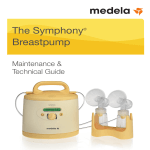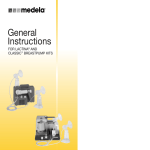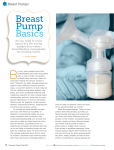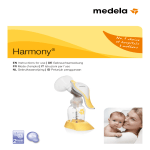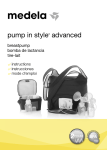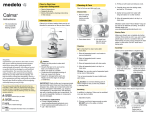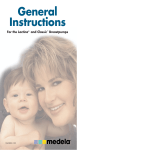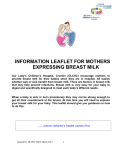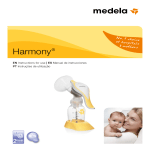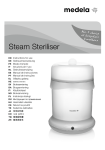Download Double Duet Breastmilk Initiation Kit Instructions
Transcript
double duet breastmilk initiation kit instructions for use with symphony breastpump includes harmony manual breastpump double or single pumping kit 24 mm and 27 mm PersonalFit™ breastshields DEHP and Latex free 67355S Double Duet Breastmilk Initiation Kit To • • • purchase non-sterile replacement parts: Locate a Medela retailer at http://medela.findlocation.com Email [email protected], or Call 1-800-435-8316 24 mm PersonalFit™ Breastshield (2) 87073 Let-down Symbol Handle (1) 8007262 Diaphragm (1) Stem w/ 8007034 O-Ring (1) O-Ring (1) Connector (2) 8107236 Yellow Valve (2) 80789 White Membrane (2) Colostrum Collection Container (2) 27 mm PersonalFit Breastshield (2) 80 mL Collection Container with Lid (2) 87074 Tubing (2) 8007213 Membrane Cap (2) 8100769 Membrane (2) 8200094 Container Lid (2) 8107181 Spare Membranes 87088 Which Container When Medela’s 35 mL colostrum container has 20 mL of pumping capacity and 35 mL of storage capacity. The curved bottom minimizes loss of colostrum or breastmilk during transfer to a syringe. The small size helps keep mothers motivated to pump by setting proper expectations of initial milk production. Medela’s 80 mL breastmilk collection container has 65 mL of pumping capacity and 80 mL of storage capacity. Visit your Medela retailer or go to www.medela.com for our selection of larger breastmilk collection & storage containers. Pumping Should Be Comfortable When it comes to finding the right fit in a breastshield every mother is different. Sizing may change throughout your breastfeeding experience as the breast and nipple tissue changes. To determine the correct size breastshield, you need to watch your breasts while pumping. 24 mm 27 mm While pumping— You should see the following if you have the correct size breastshield: •Pumping feels comfortable, not painful. •The nipple is centered and moves freely in the tunnel. •Minimal or no areolar tissue is pulled into the tunnel of the breastshield. •There is gentle rhythmic motion in the breast with each cycling of the pump. areola tunnel breastshield •The breast empties all over. After pumping gently press around your breast. If an area still feels full or a bit firmer, you may not have emptied the milk duct in that area of the breast. After pumping— •After a pumping session the nipple is not irritated and is not painful to the touch. If you do not see the above, you may need to seek the advice of a lactation or healthcare professional to assist you in getting the proper fit. Double Duet Breastmilk Initiation Kit Important This product is sterile. Package must be inspected for any holes, broken seals, or damage before opening. If present, you MUST wash product prior to first use. If you have any other questions, consult with your healthcare provider for further cleaning instructions. Online Breastfeeding Resources •To learn more about storing and caring for your breastmilk: www.BreastmilkGuidelines.com •For free advice from a lactation consultant: www.medelabreastfeedingus.com/for-expectant-mothers/ ask-the-lc •For breastfeeding tips & solutions including: • • • • • How to breastfeed Challenges & solutions Going back to work Breastpumping Choosing the right size breastshield www.medelabreastfeedingus.com/for-expectant-mothers/tips-andsolutions •For help with choosing a breastpump: www.medelabreastfeedingus.com/product-selector If you experience discomfort while pumping, contact your lactation professional as you may need a different size breastshield. To locate Medela products, visit http://medela.findlocation.com or call 1-800-TELL-YOU. Single User Caution: This product is a personal care item that should not be shared between users. Symphony® Pumping Kit Assembly & Use Wash hands with soap and water prior to handling your kit. 1 S ecurely attach breastshields to connectors. (Note: See inside cover for selecting the proper size breastshield.) 4 S crew collection containers onto connector bottom. (Note: See inside cover for selecting the proper size container.) 2 S nap white membranes onto yellow valves until membranes lie flat. 3 P ush yellow valves onto inner ring of connector bottom. 5 Insert pale yellow round ends of tubing into openings in back of connectors. 6 Insert the triangular 7 Fit protective two-toned yellow membranes onto ends of tubing into membrane caps. ports on membrane caps. 2 9 Push membrane 8 T o open lid, hold 10 Close lid before caps into place on down the oval pumping. the pump. A “click” button on the top of (If lid does not will be heard once the Symphony close, check to see properly seated. breastpump and that membrane (Note: If single lift up on the caps are properly pumping, only seat handle. seated.) one membrane cap.) 13 If let-down 11 Center breastshields 12 To turn the pump occurs before the over your nipples on, press the power Expression Phase and start pumping. button. You will be begins, press the (Caution: pushing starting in the let-down button shields too firmly into Stimulation Phase. to begin the breasts may reduce Expression Phase. milk flow.) 14 When your pumping session is over, store your breastmilk and clean your kit. See the Breastpump Kit Care section for cleaning instructions. For breastmilk storage guidelines go to www.BreastmilkGuidelines.com 3 Harmony™ Kit Assembly & Use 1 S ecurely attach breastshield to connector. 2 S nap white membrane onto yellow valve until membrane lie flat. Wash hands with soap and water prior to handling your kit. 3 P ush yellow valve onto inner ring of connector. Correct 4 S crew collection container onto connector. Incorrect Hint: Make sure the oval shape is lined up correctly in the diaphragm. 4 5 P lace oval shaped base of the stem into diaphragm. 6 A lign silicone diaphragm/stem with tab on pump handle. Press down firmly around entire edge to ensure a proper seal. 7 Insert stem of 8 Center breastshield handle assembly over nipple. into opening on top (Caution: pushing of connector and shield too firmly into push until you feel breast may reduce it snap in. milk flow.) 11 Once let-down 9 R otate the 10 Start pumping in has begun, switch adjustable handle the Stimulation to the Expression for your maximum Phase by pressing Phase by pressing pumping comfort. down on the milk the back of the The level of vacuum drops symbol pump handle. is controlled by the on front of This mode mimics compression and the pump handle. baby’s deeper, the speed of the Press and release more relaxed handle stroke. You quickly until you sucking and decide the pumping see milk flow is designed to rhythm that is best begin. This mode maximize milk flow. for you. mimics baby’s initial rapid sucking and is designed to stimulate milk flow/ let-down. 12 When your pumping session is over, store your breastmilk and clean your kit. See the Breastpump Kit Care section for cleaning instructions. For breastmilk storage guidelines go to www.BreastmilkGuidelines.com 5 Converting to the Symphony® Breastpump 1 R emove handle assembly from connector. 2 Insert pale yellow round end of tubing into opening on top of connector. See Symphony Kit Assembly on page 2 and refer to steps 6-14 to complete assembly. Breastpump Kit Care Good hygiene will help protect the breastmilk that you give to your baby. For the best protection when handling your breastmilk, wash your hands with soap and water, and follow the guidelines for cleaning, drying, and storing your kit. 6 How do I disassemble my kit? 1 Finish pumping. Symphony: (Note: It is important to let pump run for 2 minutes with tubing attached. This will eliminate condensation that naturally results from humidity.) While the pump is still running, disconnect tubing from connector. Both Symphony and Harmony: 2 R emove collection container(s) and store breastmilk. For breastmilk storage guidelines go to www. BreastmilkGuidelines.com. 3. Disassemble. ll parts that come in contact with your breast and A breastmilk must be disassembled and washed for the kit and pump to function efficiently. Harmony: a R emove the pump handle assembly from the connector. Check to see if it needs cleaning. Note: Under normal use, the pump handle and diaphragm/stem only need to be cleaned periodically or when it is apparent they have become soiled. (Hint: Do not remove small white o-ring from stem.) Continue to step b on next page. 7 How do I disassemble my kit? (cont’d.) Both Symphony® and Harmony™: eparate remaining parts of your kit that come in contact with your S breast and breastmilk. b S eparate breastshield(s) from connector(s). c T wist and pull the yellow valve(s) off the connector(s). d R emove the white membrane(s) from the valve(s). Cleaning 1 Wash parts. Rinse all separated parts in cool water to remove breastmilk. 2 Wash and Rinse -or- •Wash all separated parts in warm, soapy water. •Rinse all separated parts with clear water. 8 Dishwasher •Wash all separated parts on top rack of dishwasher. Drying & Storing Allow all breastpump kit parts to air dry in a clean area and store dry parts when not in use. Do NOT store wet or damp parts. Sanitizing In addition to washing, you may sanitize your kit parts that come in contact with breast and breastmilk once per day by following the instructions on Medela’s Quick Clean™ Micro-Steam™ bag or boiling. Note: Do NOT use Quick Clean Micro-Steam bags with the Harmony pump handle, diaphragm/stem and breastshield connectors. If boiling your kit: 1 S eparate all parts that come in contact with your breast and breastmilk. 2 Choose a pot that is large enough so the kit parts DO NOT rest on the sides or bottom while boiling. 3 Fill the pot with water and bring to a boil. 4 Carefully drop parts into boiling water, and boil for 10 minutes. 5 Gently remove parts from water with tongs and place on a clean surface. 6 See Drying & Storing section (above) for further instructions. Quicker Cleaning You can use Medela’s Quick Clean wipes in between pumping sessions and then clean your kit once you get home. Follow instructions on Quick Clean package. 9 Breastpump Kit Care Tubing Care It is not necessary to clean tubing after each use. If your tubing comes in contact with breastmilk, clean it by following these directions. •Rinse and run cold water through tubing to remove breastmilk. •Dry tubing by attaching it to pump and running for 2 minutes or until dry. This will eliminate condensation that naturally results from humidity. •In addition to washing, you may sanitize by following the instructions on page 9. • Tubing may appear cloudy after boiling or microsteaming. To Sterilize Kits in the Hospital Important Note: Do NOT autoclave Harmony handle, diaphragm/ stem and breastshield connectors. All disassembled parts can be autoclaved to a maximum of 272° F for 3 minutes at 29 PSIG or 250° F for 15-20 minutes at 15 PSIG. To avoid damage during and immediately after sterilization: •Sterilize parts without applying external pressure. •Allow parts to cool before applying external pressure. Note: If gas sterilization is used, residual testing is recommended to determine the proper length of aeration. Tips for Success •Prior to pumping, relax, take a few deep breaths and think of your baby. •Using a breastpump should be easy and comfortable. The first few times may seem a bit awkward, but you will quickly find your best position and pumping speed. •Many new mothers find that in the first week or two of breastfeeding, they may experience nipple tenderness and soreness. This is normal and will improve as both mom and baby learn this new skill. If soreness persists, contact a lactation consultant or healthcare provider to assist in proper breastshield sizing or comfortable breastfeeding techniques. •To soothe sore nipples, you may purchase Tender Care products by visiting your Medela retailer. To locate a retailer visit www.medela.com or call 1-880-TELL YOU. 10 Troubleshooting If you feel the pump is not giving sufficient suction, you can check several things: •Make sure the white membrane is clean and lies completely flat on the yellow valve. •Verify that yellow valve on breastpump kit is fitted correctly into the breastshield connector. Symphony® Breastpump Troubleshooting •Make sure breastpump is plugged in. •Check and secure all connections of kit and breastpump. •Ensure that the pale yellow ends of the tubing fit securely into connectors and the triangular two-tone yellow ends into the membrane caps. (Refer to Symphony kit assembly instructions.) •Inspect Symphony membranes. If membranes appear to be worn or have a tear they need to be replaced (Article # 8200094). Harmony™ Breastpump Troubleshooting •Make sure the stem assembly on the pump handle is seated all the way into the pump body until it will go no further. Make sure the white o-ring is in place in the stem handle. •Make sure the oval base of the stem is properly seated in the oval base of the diaphragm. •Finally, make sure the diaphragm is pushed all the way onto the circular rim on the underside of the handle. •If pump handle does not release smoothly or sticks, check diaphragm assembly to correct. (Refer to step 6 of the Harmony Kit Assembly Instructions on page 4.) If assistance is still needed after reviewing this booklet, please email Medela Customer Service at [email protected] or call (800) 435-8316 or (815) 363-1166. 11 Medela, Inc. P.O. Box 660 1101 Corporate Drive McHenry, IL 60051-0660, USA Ph: (800) 435-8316 or (815) 363-1166 Fax: (815) 363-1246 Email: [email protected] www.medela.com Medela and Symphony are registered trademarks of Medela in the USA. PersonalFit, Quick Clean and Micro-steam are trademarks of Medela, Inc. in the USA and in other countries. Applications for registration of Medela is pending in other countries. © 2011 Medela, Inc. Printed in the U.S.A. Medela, Symphony y Lactina son marcas registradas de Medela en EE.UU. PersonalFit, Quick Clean y Micro-steam son marcas comerciales de Medela, Inc. en EE. UU. y en otros países. Solicitudes de registro de Medela en trámite en otros países. © 2011 Medela, Inc. Impreso en los EE.UU. © 2011 Medela, Inc.
















